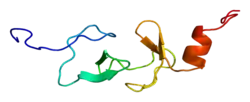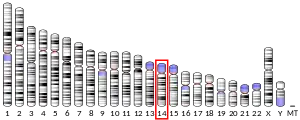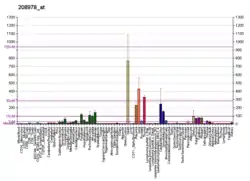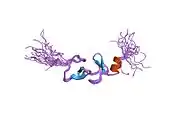| CRIP2 | |||||||||||||||||||||||||||||||||||||||||||||||||||
|---|---|---|---|---|---|---|---|---|---|---|---|---|---|---|---|---|---|---|---|---|---|---|---|---|---|---|---|---|---|---|---|---|---|---|---|---|---|---|---|---|---|---|---|---|---|---|---|---|---|---|---|
 | |||||||||||||||||||||||||||||||||||||||||||||||||||
| |||||||||||||||||||||||||||||||||||||||||||||||||||
| Identifiers | |||||||||||||||||||||||||||||||||||||||||||||||||||
| Aliases | CRIP2, CRIP, CRP2, ESP1, cysteine rich protein 2 | ||||||||||||||||||||||||||||||||||||||||||||||||||
| External IDs | OMIM: 601183 HomoloGene: 135666 GeneCards: CRIP2 | ||||||||||||||||||||||||||||||||||||||||||||||||||
| |||||||||||||||||||||||||||||||||||||||||||||||||||
| |||||||||||||||||||||||||||||||||||||||||||||||||||
| |||||||||||||||||||||||||||||||||||||||||||||||||||
| |||||||||||||||||||||||||||||||||||||||||||||||||||
| Wikidata | |||||||||||||||||||||||||||||||||||||||||||||||||||
| |||||||||||||||||||||||||||||||||||||||||||||||||||
Cysteine-rich protein 2 is a protein that in humans is encoded by the CRIP2 gene.[3][4][5][6]
CRIP2 and the closely related CRIP1 are cysteine-rich proteins containing two LIM domains. They are highly expressed during cardiovascular development and act to bridge serum response factor and GATA proteins and stimulate smooth muscle target genes.[7]
References
- 1 2 3 GRCh38: Ensembl release 89: ENSG00000182809 - Ensembl, May 2017
- ↑ "Human PubMed Reference:". National Center for Biotechnology Information, U.S. National Library of Medicine.
- ↑ Tsui SK, Chan PP, Cheuk CW, Liew CC, Waye MM, Fung KP, Lee CY (Feb 1997). "A novel cDNA encoding for a LIM domain protein located at human chromosome 14q32 as a candidate for leukemic translocation". Biochem Mol Biol Int. 39 (4): 747–54. doi:10.1080/15216549600201831. PMID 8843343. S2CID 25981657.
- ↑ Karim MA, Ohta K, Egashira M, Jinno Y, Niikawa N, Matsuda I, Indo Y (January 1996). "Human ESP1/CRP2, a member of the LIM domain protein family: characterization of the cDNA and assignment of the gene locus to chromosome 14q32.3". Genomics. 31 (2): 167–76. doi:10.1006/geno.1996.0028. PMID 8824798.
- ↑ Huber A, Neuhuber WL, Klugbauer N, Ruth P, Allescher HD (Mar 2000). "Cysteine-rich protein 2, a novel substrate for cGMP kinase I in enteric neurons and intestinal smooth muscle". J Biol Chem. 275 (8): 5504–11. doi:10.1074/jbc.275.8.5504. PMID 10681529.
- ↑ "Entrez Gene: CRIP2 cysteine-rich protein 2".
- ↑ Chang DF, Belaguli NS, Iyer D, Roberts WB, Wu SP, Dong XR, Marx JG, Moore MS, Beckerle MC, Majesky MW, Schwartz RJ (January 2003). "Cysteine-rich LIM-only proteins CRP1 and CRP2 are potent smooth muscle differentiation cofactors". Dev. Cell. 4 (1): 107–18. doi:10.1016/S1534-5807(02)00396-9. PMID 12530967.
External links
- Human CRIP2 genome location and CRIP2 gene details page in the UCSC Genome Browser.
Further reading
- Maruyama K, Sugano S (1994). "Oligo-capping: a simple method to replace the cap structure of eukaryotic mRNAs with oligoribonucleotides". Gene. 138 (1–2): 171–4. doi:10.1016/0378-1119(94)90802-8. PMID 8125298.
- Suzuki Y, Yoshitomo-Nakagawa K, Maruyama K, et al. (1997). "Construction and characterization of a full length-enriched and a 5'-end-enriched cDNA library". Gene. 200 (1–2): 149–56. doi:10.1016/S0378-1119(97)00411-3. PMID 9373149.
- Strausberg RL, Feingold EA, Grouse LH, et al. (2003). "Generation and initial analysis of more than 15,000 full-length human and mouse cDNA sequences". Proc. Natl. Acad. Sci. U.S.A. 99 (26): 16899–903. Bibcode:2002PNAS...9916899M. doi:10.1073/pnas.242603899. PMC 139241. PMID 12477932.
- van Ham M, Croes H, Schepens J, et al. (2004). "Cloning and characterization of mCRIP2, a mouse LIM-only protein that interacts with PDZ domain IV of PTP-BL". Genes Cells. 8 (7): 631–44. doi:10.1046/j.1365-2443.2003.00660.x. PMID 12839623.
- Ota T, Suzuki Y, Nishikawa T, et al. (2004). "Complete sequencing and characterization of 21,243 full-length human cDNAs". Nat. Genet. 36 (1): 40–5. doi:10.1038/ng1285. PMID 14702039.
- Lim J, Hao T, Shaw C, et al. (2006). "A protein-protein interaction network for human inherited ataxias and disorders of Purkinje cell degeneration". Cell. 125 (4): 801–14. doi:10.1016/j.cell.2006.03.032. PMID 16713569.
This article is issued from Wikipedia. The text is licensed under Creative Commons - Attribution - Sharealike. Additional terms may apply for the media files.



